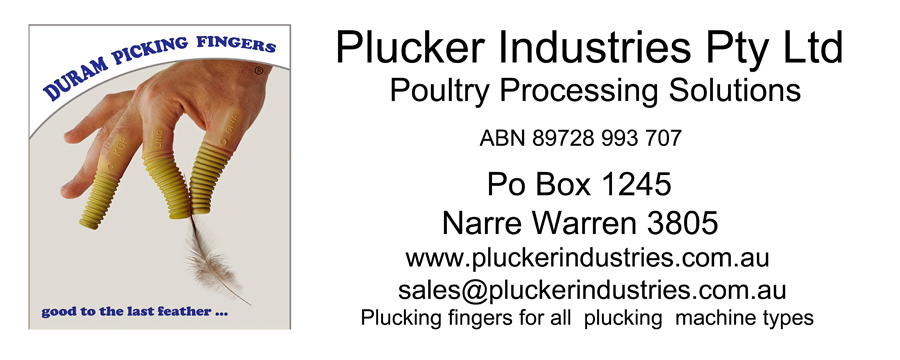Tips for the home processor. by Jim.
Like many things, ask 6 experts in a room and you will have 10 answers, and about half of them will be right. So select a method, stick to it if you get results, and experiment, and if necessary email to Ask an expert!! for advice.
Selecting a finger is mostly just about using the same fingers as the manufacturer has supplied.
Give me answers to the following questions and mostly fingers are a standard fit.
Size of the holes, length of the finger inside the drum, diameter of the drum, type and weight of the birds.
Good processing is a combination of the machine you have, and the techniques you use.
But what if the machines are no name, or the manufacturer has long since disappeared.
The size of the plucker. Diameter of the holes, approx. length of the finger inside the drum, are the critical ones. Rotation speed matters only if you have made alterations to the base design.
Then the type of the birds matters. Large birds want a longer finger, larger in diameter. Small birds want a shorter, softer finger. Quail want special fingers.
The third is the weight of the birds. Generally heavier the birds, larger diameter finger and a harder finger, and sometimes a longer finger
The Fourth is the scalding method. This is usually arrived at by trial and error. Water temperature, and scald time, are the two factors.
One useful tip. A few drops of dishwashing detergent in the scald water will ensure water “wets” the feather and allows the water to penetrate to the skin, especially for ducks and geese.
These combine into three different basic styles.
Cold scald, water temperature of tap water, immersion time several minutes, plucking time longer, usually harder fingers M90 or M110.
Soft Scald, water temperature 50 degrees, about 1-2 minute immersion ( until thigh feathers rub off easily) plucking time much shorter, usually M60 grade sometimes large birds M90 grade.
Hard scald, water temperature 60-80 degrees, time just until feathers rub off, usually 20-30 seconds, plucking time short, M60 hardness of fingers. Immediately immerse in cold water after plucking to avoid discolouration of skin. The fastest method but most likely to damage skin. Precision and practice required. Some use a water spray to help move the feathers away. Start spraying once the first layer of feathers is filling up the machine.
Plucking tips.
1/ Getting the fingers into the machine.
This can be a bit tricky especially with the harder fingers. Some people use big pliers but there is a need for caution of broken fingers can result. I find the best is to dip the but end of the finger into some vegetable oil, before placing the tapered end into the hole, then pull the finger into place, with a slight wobble side to side. It can be a bit messy, but if the hole size is right they should snap into place.
2/ Now the action part, removing feathers. Watch the birds!
Too many birds in the plucker will not allow the birds to tumble. Start doing one bird. First try soft scald, and get it right. Run the plucker, and drop the bird into the middle. Watch the bird, if all is well the bird will tumble in the plucker, so all sides end up in contact with the fingers. This will cause a two way, end over end, and side to side motion of the bird. All feathers should come off quickly and cleanly. Lots of feathers which won’t come off no matter how long the bird is in the machine, usually means increase the scald temperature and lengthen the time of scald.
Once that is right, try with two birds. In most pluckers the result will be the same. Keep doing batches with one extra bird each time. If you add another and the birds loose the tumbling action, there are too many birds in the plucker, or maybe they need harder fingers. Make a note of the number and bird weight, so next time you will remember what you did. Damaged birds may be the result of too hot scalding, too hard fingers. Part plucked birds could be insufficient scalding either with temperature too low or for too little time, or too many birds in the plucker so they don’t tumble properly in the plucker.
Another tip, look down the drum on the inside, with some birds running in it. You will see the fingers bent over like the illustration below. The weight of the birds moving is bending the fingers over. If the fingers are up straight, they are too hard, likely to damage the bird. They should be bent over so the ridges are parallel with the wall of the plucker, bent over so the rubber ridges of the fingers are removing feathers, this is just right. If they are bent right over with the weight of the bird, the fingers are too soft , likely to break the fingers or take a long time to pluck, or have only part of the feathers removed because the tumbling of the bird stops.
Too hard, Just right, Too soft.

